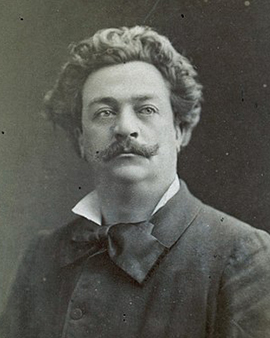


In the pulsating alleys of Paris, under the dim light of old street lamps, a future genius was born on October 17, 1840. André Gill, born Louis-Alexandre Gosset de Guînes, entered a world marked by art, revolution and upheaval. Once born the natural son of the Comte de Guînes and the talented seamstress Sylvie-Adeline Gosset, it turned out that this name was merely the prelude to a captivating chapter of his life. His career began with impressive contributions to "Le Journal amusant," but his name went down in the annals as the preeminent cartoonist of the Second Empire, when he delighted audiences with his distinctive portrayals of figures such as Victor Hugo, Jules Verne, and Otto von Bismarck.
His artwork was characterized by oversized heads and sculpted bodies that occasionally bore animal attributes or angel wings. Such a unique art print would no doubt beautify any room in which it was placed. However, Gill's journey through artistic life was not always rosy. His talent and tendency towards controversy meant that his work was often targeted by censors, especially his captivating depictions in "La Lune" and "L'Éclipse". Despite the challenges he faced, his determination and commitment to art was remarkable.
He joined the Fédération des artistes, a movement founded by Gustave Courbet that advocated for the freedom of art. This was a statement, an outcry against the restrictions and censorship that plagued the artists of his time. Away from the screen, Gill was also an esteemed chansonnier who frequented the legendary Cabaret des Assassins in Montmartre. It was here that he left another unforgettable legacy: a sign featuring a tipsy rabbit. A simple sign that eventually inspired the cabaret's name - "Au Lapin Agile", a play on words meaning "the nimble rabbit" or "the rabbit of Gill".
Despite the fame and admiration he gained in his career, the shadows of fate hit him hard. At the end of his life, he suffered from mental illness and spent his last days in Charenton. But André Gill's legacy lives on, both in the alleys of Paris and in the hearts of art lovers worldwide. Visiting his grave at Père-Lachaise Cemetery or admiring a bust at the end of a small alley in Montmartre are testaments to his undying presence. An art print of André Gill's works is not only a tribute to his genius, but also a piece of history that you can experience in your own home.

In the pulsating alleys of Paris, under the dim light of old street lamps, a future genius was born on October 17, 1840. André Gill, born Louis-Alexandre Gosset de Guînes, entered a world marked by art, revolution and upheaval. Once born the natural son of the Comte de Guînes and the talented seamstress Sylvie-Adeline Gosset, it turned out that this name was merely the prelude to a captivating chapter of his life. His career began with impressive contributions to "Le Journal amusant," but his name went down in the annals as the preeminent cartoonist of the Second Empire, when he delighted audiences with his distinctive portrayals of figures such as Victor Hugo, Jules Verne, and Otto von Bismarck.
His artwork was characterized by oversized heads and sculpted bodies that occasionally bore animal attributes or angel wings. Such a unique art print would no doubt beautify any room in which it was placed. However, Gill's journey through artistic life was not always rosy. His talent and tendency towards controversy meant that his work was often targeted by censors, especially his captivating depictions in "La Lune" and "L'Éclipse". Despite the challenges he faced, his determination and commitment to art was remarkable.
He joined the Fédération des artistes, a movement founded by Gustave Courbet that advocated for the freedom of art. This was a statement, an outcry against the restrictions and censorship that plagued the artists of his time. Away from the screen, Gill was also an esteemed chansonnier who frequented the legendary Cabaret des Assassins in Montmartre. It was here that he left another unforgettable legacy: a sign featuring a tipsy rabbit. A simple sign that eventually inspired the cabaret's name - "Au Lapin Agile", a play on words meaning "the nimble rabbit" or "the rabbit of Gill".
Despite the fame and admiration he gained in his career, the shadows of fate hit him hard. At the end of his life, he suffered from mental illness and spent his last days in Charenton. But André Gill's legacy lives on, both in the alleys of Paris and in the hearts of art lovers worldwide. Visiting his grave at Père-Lachaise Cemetery or admiring a bust at the end of a small alley in Montmartre are testaments to his undying presence. An art print of André Gill's works is not only a tribute to his genius, but also a piece of history that you can experience in your own home.
Page 1 / 7










